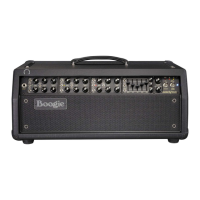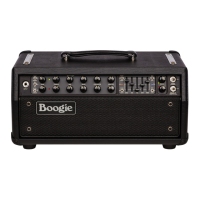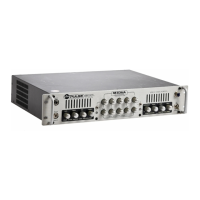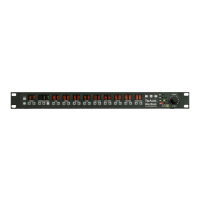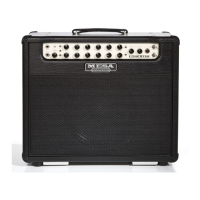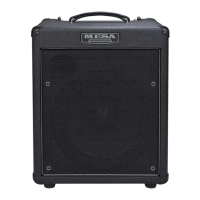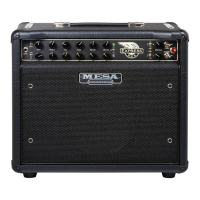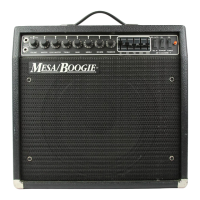PAGE 11
90W SIMULCLASS™
This uppermost position engages all four power tubes to produce 90 watts (full power) of Simul-Class power.
Our unique and patented Simul-Class, in short, wires two of the tubes (outside pair) in Class A/B and two of
the tubes (inside pair) in Class A to arrive at the smoothest, sweetest, most harmonically rich “100-watt” power
section on the planet. That is a bold statement, however, 40 years of success with this unique power section
backs it up with thousands of happy customers worldwide over five previous MARK models, including some of
the biggest names in guitar adding their endorsement of its incredible tone and feel.
Combining Class A/B wiring’s high eciency/low heat and fast-transient/bold dynamic characteristics with the
inecient/high heat yet smooth-transition-to-clip signature of Class A wiring creates the ultimate tube power.
The eciency and headroom of Class A/B married to the sweet clip-ability and harmonic enhancement of Class
A. The 90-Watt Mode is high headroom, superb balance, and sweet musicality – all showcased in one phenom-
enal power amp. The inherent smile, 3-D low end, and perfectly scooped midrange, coupled with diminished
lower (harsher) harmonics and an emphasis on higher, sweeter ones, results in nothing short of magic in terms
of tone and voice. Simul-Class really has to be experienced to be fully appreciated.
Having the two iconic Classes of operation occurring simultaneously in the same power amplifier is the pin-
nacle of tube power tech. It was a huge MESA milestone in the early ‘80s when first introduced on our MARK
IIB, and to this day, it remains a mainstay in our MARK Series production. Catapulting IIBs onto the world stage,
it has been a valuable component in capturing artist loyalty and elevating MARK Series amplifiers to icons
throughout the last four decades.
Simul-Class cancels out the harsh artifacts produced by CLASS A/B’s sacrifices toward eciency while at the
same time it embellishes CLASS A’s ineciencies and minimizes heat to arrive at the nexus between vintage
response and modern power.
45W
This middle position on each Channel’s Power Select toggle renders the two outermost power tubes in standby
mode and leaves the two inner power tubes wired in Class A Pentode operational. As you might guess, this
produces 45 watts, approximately half the power, and displays a dierent set of sonic characteristics.
Generally speaking, the sound will be less bold and punchy in the midrange and have less low-end girth and
width. The top end will also be brighter and have more “give” to it, and some describe it as having a more
bubbly, elastic character. The 45 Watt setting will also present somewhat reduced headroom and volume. The
onset of clipping will occur earlier, and this is most noticeable in the first two Channels in CLEAN and FAT set
for very clean sounds where the GAIN is at or below approximately 12:30, depending on the guitar and pickups.
In regard to output volume, though you would imagine by the wattage numbers that the volume (loudness)
would be cut roughly in half by the power reduction, the impression for most players is that volume is reduced
by more like a third, as the amp can still be loud depending on settings, cabinetry, and room. At lower MASTER
settings, you may not notice the volume drop much at all and be more aware of only the tonal dierences
mentioned above. This is normal.
The 45-watt setting shines for classic rock, Americana, roots, or blues, and styles leaning more toward the
traditional than it does modern rock or metal styles. The earlier, smoother transition to clipping and brighter,
more forgiving response make it lean old school, as it will have a looser, more clip-able low end along with the
enhanced harmonics up top. These characteristics don’t really align with huge gained-up chording or tight-
tracking bass lines saturated with high gain. For those Heavy styles, the 90-watt setting is far more appropriate.
However, if it’s classic rock rhythm or single note soloing that needs to be bright and cut yet also have an ex-
pressive leading edge full of harmonic richness and perhaps a bit of clip, 45 Watts could be the perfect choice.
The same applies to clean chording and soloing. If you need maximum headroom and authority with accuracy
and percussive impact for really clean work or more modern styles, the 90-watt setting would be most appro-
priate. However, if you want a more Trad response with the ability to have a looser, clipped leading edge and
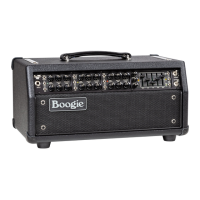
